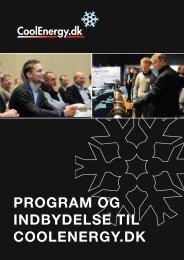Competitive chiller concept with water as refrigerant
Competitive chiller concept with water as refrigerant
Competitive chiller concept with water as refrigerant
You also want an ePaper? Increase the reach of your titles
YUMPU automatically turns print PDFs into web optimized ePapers that Google loves.
the plants and for the compressor. The vapor pressure of <strong>water</strong> is relatively low and for all temperatures below<br />
100°C it is lower than atmospheric pressure, i.e. the process runs in vacuum conditions for the temperature<br />
ranges typical for <strong>chiller</strong> operation.<br />
Figure 1 shows that the vapor pressure at a typical <strong>chiller</strong> temperature of 6-7°C is approximately 10 mbar<br />
absolute pressure while the pressure at typical condensation temperatures 25 -35°C ranges from approx. 30 to<br />
60 mbar absolute pressure. Because of the very low pressure the specific volume for <strong>water</strong> vapor is very large<br />
<strong>as</strong> shown in Figure 1.<br />
Figure 1<br />
Left: Saturation pressure for <strong>water</strong> <strong>as</strong> a function of temperature,<br />
Right: Specific volume of <strong>water</strong> vapor.<br />
Figure 2 Various types of turbo compressors were evaluated in collaboration <strong>with</strong><br />
ConceptsNREC, USA. The choice fell on the multistage axial compressor type (bottom<br />
right) <strong>as</strong> the most promising candidate - all things considered.<br />
At typical <strong>chiller</strong> temperatures (6-7°C), the specific volume is in the order of 130 to 140 m 3 /kg and <strong>as</strong> the<br />
latent heat for <strong>water</strong> is about 2.4 MJ/kg it means that an approx. 2 MW plant - which the fe<strong>as</strong>ibility study w<strong>as</strong><br />
b<strong>as</strong>ed on - must have a compressor volume flow of approx. 100 m 3 /s. Such conditions restrict the range of<br />
potential types of compressors to the relatively large turbo compressors, and a variety of candidates <strong>as</strong> shown<br />
in Figure 2 were examined on a number of parameters including production methods, material selection,<br />
flexibility etc., in addition to the mentioned three main parameters.<br />
The conclusion of the fe<strong>as</strong>ibility study w<strong>as</strong> positive; there w<strong>as</strong> a chance to develop a system that could be<br />
competitive on all three parameters – size, cost and COP – by selecting the <strong>concept</strong>:<br />
• The development of the axial compressor type <strong>as</strong> shown in figure 2, bottom right, in a special cost<br />
effective way.<br />
• In combination <strong>with</strong> an optimized version of the direct contact heat exchangers.<br />
In this way, the systems b<strong>as</strong>ed on <strong>water</strong> <strong>as</strong> media (sketched in Figure 3) would be able to compete <strong>with</strong><br />
traditional plants b<strong>as</strong>ed on NH 3 or the synthetic HCF <strong>refrigerant</strong>s on entirely commercial b<strong>as</strong>is. The sketch<br />
shows the approximate operational conditions for the unit, the developed compressor offers sufficient margin to<br />
be able to operate on a global scale of applications.




